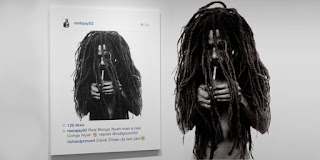Kylie Minogue’s fashion range loses copyright It claim
 Australian pop star Kylie Minogue is associated with a range of interior design and bed linen products, produced by Ashley Wilde. In a recent action, this design company went on to sue BCPL, a brand which sells bed linen products, primarily owned by another well-known model and TV star Caprice Bourret. The subject of the litigation was with respect to a duvet cover (the cotton shell which covers a comforter) and a matching runner. The allegations of similarity were concerned with the following factual determinations (as reported in the IPKat):
Australian pop star Kylie Minogue is associated with a range of interior design and bed linen products, produced by Ashley Wilde. In a recent action, this design company went on to sue BCPL, a brand which sells bed linen products, primarily owned by another well-known model and TV star Caprice Bourret. The subject of the litigation was with respect to a duvet cover (the cotton shell which covers a comforter) and a matching runner. The allegations of similarity were concerned with the following factual determinations (as reported in the IPKat):- The choice of a the pattern of scallop-style pleats in repeating horizontal rows;
- The relative size of each pleat;
- The relative spacing between each pleat; and
- The relative spacing between each horizontal row.
Justice Melissa Clarke firstly went on to establish that a presumption of copying will exist if the works are primarily substantially similar and there is proof of access to the prior work. However, she then went on to reiterate the rule that the question of copying concerns with the quality of the work, and not merely the quantity taken, and whether the intellectual expression and creation of the author is appropriated or not. It is not just the similarities but also the differences which need to be looked at, and the copyright needs to be determined as a whole. The differences cannot be downplayed, as was done in the case at hand.
These jurisprudential notes in combination with the determination that scallop-style pleats were relatively commonplace in the fashion industry and could not be monopolized due to it being a concept (Idea-Expression dichotomy), led the court to reject a finding of presumption of copying. Apart from this, the court found that the expression of such scallop-style pleats in the conflicting designs, in fact, encompassed sufficient differences and were not in any case substantially or extensively similar to bring in a case for the presumption of copying. The differences in the method of pleating the scallops, the number of pleats in the pleated scallops, the size of the pleated scallops and the shape of the pleated scallops, the number of repeated scallop motifs were rendered to be sufficient to avoid a claim for infringement and to establish an original distinct expression of a design made out of the concept of a scallop-styled pleat. In lieu of the same, the court rejected a finding of copyright infringement and Ashley Wilde was unsuccessful in the action.
Interestingly, this case reinforces the importance of factual evaluation and the fine line between inspiration and infringement especially in the fashion industry, to recognize the multitude of possibilities of expression in a copyrightable design and its dominion, and balance the interests of the copyright holder and the general public (other designers in the fashion industry) accordingly. It reinforces the principle of creative freedom and the leeway of experimentation on similar ideas, provided in copyright, to account for designs, which may prima facie seem similar intuitively, but are much more detailed and different when such details are analyzed. The judgment can be found here.
Versace sues Fashion Nova for infringement of the gold “Barocco” print
 In yet another infringement action concerning the Fashion industry, Italian brand Versace has sued Fashion Nova to seek a remedy and redress with respect to the copyright infringement of its apparel involving the black and gold “Barocco-57” print, pop-hearts design the “Jungle print dress” that was worn by Jennifer Lopez in the Grammy Award functions. This case has been lodged in the US District Court for the Central District of California, as reported by the World IP review. The claim of Versace revolves around the principle of Fashion Nova deliberately riding on the popularity and renown of Versace’s signature designs and its valuable goodwill and business reputation, to make profits. (Trademark logic?) The use has been alleged to be within the content, text, and meta-tags of the Fashion Nova website, as well as on social media websites, wherein “Fashion Nova” results pop-up upon a search of Versace products, due to this infringing action, resulting in alleged misdirection of consumers. A notice has already served and despite the same, Fashion Nova has not allegedly taken down these infringing designs which are substantially similar to Versace’s copyrights, from its web-portal. Interestingly Kim Kardashian took to twitter to address this claim by tweeting: “ It’s devastating to see these fashion companies rip off designs that have taken the blood, sweat, and tears of true designers who have put their all into their own original ideas.”
In yet another infringement action concerning the Fashion industry, Italian brand Versace has sued Fashion Nova to seek a remedy and redress with respect to the copyright infringement of its apparel involving the black and gold “Barocco-57” print, pop-hearts design the “Jungle print dress” that was worn by Jennifer Lopez in the Grammy Award functions. This case has been lodged in the US District Court for the Central District of California, as reported by the World IP review. The claim of Versace revolves around the principle of Fashion Nova deliberately riding on the popularity and renown of Versace’s signature designs and its valuable goodwill and business reputation, to make profits. (Trademark logic?) The use has been alleged to be within the content, text, and meta-tags of the Fashion Nova website, as well as on social media websites, wherein “Fashion Nova” results pop-up upon a search of Versace products, due to this infringing action, resulting in alleged misdirection of consumers. A notice has already served and despite the same, Fashion Nova has not allegedly taken down these infringing designs which are substantially similar to Versace’s copyrights, from its web-portal. Interestingly Kim Kardashian took to twitter to address this claim by tweeting: “ It’s devastating to see these fashion companies rip off designs that have taken the blood, sweat, and tears of true designers who have put their all into their own original ideas.”David Gilmour involved in a legal battle for the 2015 solo-single “Rattle That Lock”.
 In a suit for copyright infringement, Pink Floyd’s iconic guitarist David Gilmour has been sued by French jingle composer Michaël Boumendil, over a four-note jingle, which Gilmour was first exposed to at a French train station and was instantly charmed. According to reports, he had approached Boumendil to seek a license to use the music in a song, wherein the agreement stipulated co-authorship for the resultant song. In a suit filed by Boumendil it is alleged alleged that instead of replaying the notes (as was stipulated in the licensing contract), Gilmour went on to interpolate the exact recorded notes. The claimant sought damages worth 450,000 Euros. When the court had to decide upon this, it was noted by the court that this infringement suit was a year after the stipulated release of the song, and hence was time-barred. But Boumendil has now more recently appealed this decision and is seeking damages for the alleged unlicensed use of this jingle, and a breach of the contract between the parties.
In a suit for copyright infringement, Pink Floyd’s iconic guitarist David Gilmour has been sued by French jingle composer Michaël Boumendil, over a four-note jingle, which Gilmour was first exposed to at a French train station and was instantly charmed. According to reports, he had approached Boumendil to seek a license to use the music in a song, wherein the agreement stipulated co-authorship for the resultant song. In a suit filed by Boumendil it is alleged alleged that instead of replaying the notes (as was stipulated in the licensing contract), Gilmour went on to interpolate the exact recorded notes. The claimant sought damages worth 450,000 Euros. When the court had to decide upon this, it was noted by the court that this infringement suit was a year after the stipulated release of the song, and hence was time-barred. But Boumendil has now more recently appealed this decision and is seeking damages for the alleged unlicensed use of this jingle, and a breach of the contract between the parties.Jay-Z sues Australian retailer over lyrics
 American rapper Jay-Z (Shawn Carter) has filed a copyright infringement lawsuit against Australian Jessica Chiha and her business “The Little Homie”, which sells hip-hop inspired clothing and apparel. The subject matter of infringement refers to the book “AB to Jay-Z” which has been created by this online retail business, to teach kids alphabets in terms of names and pictures of rappers. Since then, their imagery and names have been expended to use in a coloring book as well as clothing retail options. After being served with a legal notice, the company has maintained its defence of transformative use and fair use and has resisted the claim, which has consequently landed them in court. As far as the claim over lyrics is concerned, the lawsuit refers to the famous quote by Jay- Z: “If you’re having girl problems, I feel bad for you son, I got 99 problems but a bitch ain’t one”, which has allegedly been appropriated by the Children’s book, as it displays on its front page a quote on the same lines, which states: “If you’re having alphabet problems, I feel bad for son, I got 99 problems but my ABC’s ain’t one.”
American rapper Jay-Z (Shawn Carter) has filed a copyright infringement lawsuit against Australian Jessica Chiha and her business “The Little Homie”, which sells hip-hop inspired clothing and apparel. The subject matter of infringement refers to the book “AB to Jay-Z” which has been created by this online retail business, to teach kids alphabets in terms of names and pictures of rappers. Since then, their imagery and names have been expended to use in a coloring book as well as clothing retail options. After being served with a legal notice, the company has maintained its defence of transformative use and fair use and has resisted the claim, which has consequently landed them in court. As far as the claim over lyrics is concerned, the lawsuit refers to the famous quote by Jay- Z: “If you’re having girl problems, I feel bad for you son, I got 99 problems but a bitch ain’t one”, which has allegedly been appropriated by the Children’s book, as it displays on its front page a quote on the same lines, which states: “If you’re having alphabet problems, I feel bad for son, I got 99 problems but my ABC’s ain’t one.”These actions and use of the image, likeness, and quotes purported by Jay-Z have been alleged to be “a deliberate attempt to trade-off the reputation and goodwill of Jay-Z for own commercial gain”. As reported by Pitchfork, there have been multiple cease and desist notices sent to Chiha, however this retail business is adamant of this use being fair.
Can a claim of fair and transformative use subsist on the facts? It seems so - however, the main issue before the court would be the task to balance the transformative use factor with the commercial advantage factor of fair use and the acknowledgment of a violation of the publicity rights of Jay-Z. Use in clothing, unauthoriasedly, raises a direct claim under violation of Publicity rights, but as far as the use of likeness in the Children’s book is concerned, there is no direct commercial benefit accruing out of the use of the likeness of Jay-Z and it can be argued to be merely incidental and a transformative use of his identity. It will be interesting to see how this case shapes up in court.
Indian Production House Yash Raj Films booked for an alleged failure of royalty payments to the tune of 100 Crores to Authors
The Indian Performing Rights Society, which represents composers, lyricists and music producers has accused Bollywood production house YRF of unauthorisedly collecting and not distributing royalties worth 100 crores, legitimately belonging to authors as reported by the IPRMENT law blog. A First Information Report has been filed before the Mumbai Police Economic Offences Wing. Further, an allegation of pressurising artists to enter into signing illegal agreements has also been raised. The FIR claims that while YRF managed to extract royalties from TV broadcast platforms, it hasn’t been able to collect the same from telecoms, radio stations and music streaming platforms to pay up. The core issue involved here is the non-membership of YRF in the IPRS collecting society, which is one of the major copyright societies indulging in revenue distribution. The lacunae is primarily because of the Indian Copyright Act as although it intends that royalties must be paid to the authors via a copyright society, it does not explicitly state so. The Copyright Act does not take into account the following questions, as reported in the IPRMENT law blog:
Who is supposed to pay these non-assignable and non-waivable royalties?
Who is supposed to collect these royalties?
Are authors and the assignee of their works compulsorily required to become members of a registered copyright society to claim royalties or can they continue dealing in their own works without becoming members
Hence, due to no statutory compulsion to act through a copyright society, such dubious practices are being entered into by the Production houses, which have allegedly denied authors their claim to royalty. Recently, music composer/singer duo Salim-Sulaiman came forward in a journalistic report to state that they haven’t indulged in a work-based relationship with YRF in the last 4 years due to continuous non-payment of royalties, in spite of having allegedly collected the same. Such practices deny the authors their inalienable right to reproduction and right to receive royalty, on such assignments and the prime reason for the same is the lacunae and vagueness in the drafting of the Copyright Act of India.
$1 Billion Lawsuit on Spotify by PRO Music Rights and Sosa Entertainment
A law suit has been filed by PRO Music Rights, LLC and SOSA Entertainment, LLC alleging that Spotify failed to pay royalties on over 550,000,000 streams. Pro music rights intends to ask a Florida based jury at the trial to hold Spotify responsible for its conduct and alleged infringement, and unfair and deceptive trade practices. The case was filed on 25th November at the United States District Court for the Middle District of Florida. The suit involves an allegation of removal of content for anti-competitive reasons, engaging in unfair deceptive and business practices and inter alia refusing to pay royalties - and publicly performing songs without a licence. According to the petition, Spotify removed the Plaintiff's profile without an advance notice without ever informing the claimant why these songs were removed. The Plaintiff's songs had genuine 550,000,000 streams before being removed an was one of the most popular playlists. The petition further states:
“As it knows and claims to do, Spotify is required to remit royalty payments to Plaintiffs for the streams of their songs and to obtain public performance licenses for the public performance of songs on its platform. To date, however, Spotify has not paid full royalties for the 550,000,000+ streams of Plaintiffs’ songs on Spotify’s service”
It has also been alleged that the motive for removal of all these songs is linked with its equity deal with Music and Entertainments Rights Licensing Independent Network in order to pressurize MERLIN to terminate its contract with SOSA, as high stream counts from unknown independent acts do not generate close to the same revenue for Spotify from advertisements, as compared to mainstream acts, and do not offset the royalties owed. Further, it was alleged that 99% of the users responsible for the 550,000,000 streams of Sosa’s songs were ad-supported users rather that subscription users. Is this as a result of such discrimination on the part of Spotify against less established artists? the Plaintiff thinks so and says it's musicians have suffered economic loss. This has been alleged to be an anti-competitive practice to oust independent musicians from the music market, merely due to less revenue for streaming services. In continuation, Sosa has also alleged that”
“Spotify continues to unilaterally profit from Plaintiffs’ music; despite purporting to remove Plaintiffs’ content, some of the Plaintiffs’ music continues to stream without license via Spotify-generated playlist(s), and without any compensation made to copyright holders, in blatant disregard of the Copyright Act. Spotify is legally obligated to pay royalties for streaming music.”
This battle will be interesting for the survival and growth of the Independent music circuit. The math can be done here:
1) Mainstream artists are targeted by companies with a higher marketing budget, due to the expectation of more number of streams and popularity, resulting in more consequent advertisements (of the company). These companies offer large sums to Spotify, in lieu of the advertisements – which gives Spotify its revenue
2) Independent Artists and non-mainstream music artists have a low budget advertisement attached to them, which provides less money per stream for Spotify, due to budget advertisement companies being associated therein (less revenue per stream as compared to mainstream songs).
3) Royalties to be paid in lieu of streaming is equal because of it being a statutory amount and does not in any way vary upon the artist being mainstream or not.
4) This leads Spotify to a situation that with the enhanced popularity and number of streams of non-mainstream and indie music as well (550,000,000), they get less revenue for a large number of streams (as compared to what they would have gotten, had the streams been on mainstream songs), and they have to pay equivalent royalties to both mainstream as well as indie artists.
5) The ultimate conclusion out of this analysis is the low earning on the part of Spotify through indie artists, and equal royalties to be paid, which has led them to oust them from the market, in order to attract more streams for mainstream artists only which would lead to a higher ad revenue per stream for Spotify (when balanced with the amount of royalty to be paid, which remains constant).
At the core of this is the allegation that Spotify is contributing to the already persisting anti-competitive and unequal structure of distribution of music, wherein mainstream artists who have more funds to produce and market the music and are signed to a bigger record label are able to flourish, whereas independent artists are left marginalised - and fail to get fair compensation - or reach.
From the point of view of a musician, this is a sad state of affairs, where mere economic benefit is being preferred on the cost of access of more genuine and original content to the public, which was, in fact, the goal of copyright in the first place. This arguably de-incentives the musicians (especially independent ones) from creating music (to some extent), due to the lack of marketing capability (although money is not the sole incentive), and is not competitive or ethical practice. True or not - does that matter in a court of law?
It will be interesting to see how the court approaches this and if it enters into this socio-economic aspect of survival of musicians who do not have much access to funds to market their music and content.
Plaintiff’s petition can be read here.
This Copykat by Akshat Agrawal



















